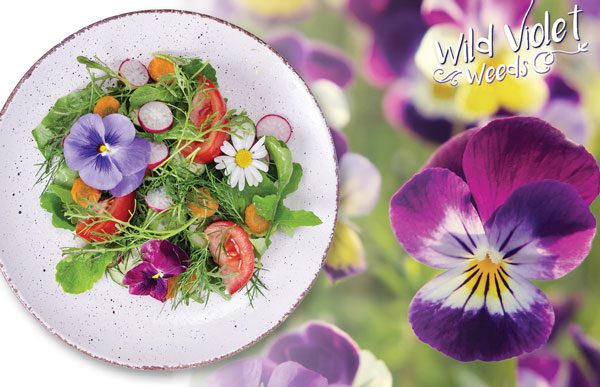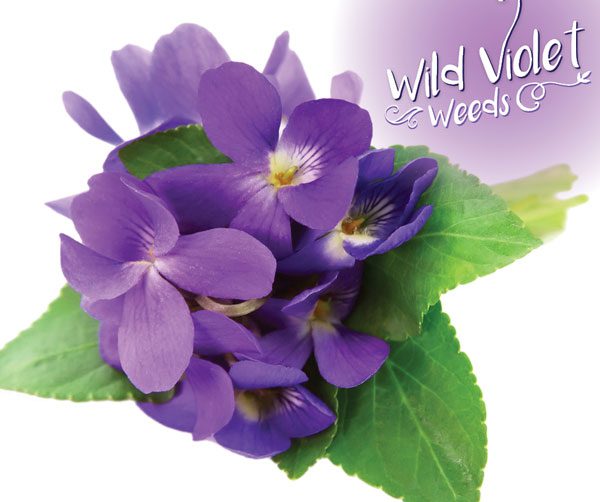Wild violets are some of the first flowers to bloom in the spring, covering lawns with tiny lilac and white flowers. Those who strive for golfing green lawns consider them weeds, but wild violets are incredibly useful and delicious to boot!
There are more than 500 species in the viola family, and most of them have exciting medicinal benefits and culinary uses. When looking for wild violets, you will frequently find Viola sororia, known as the common blue violet, the sweet violet, Viola odorata, and the Labrador violet, Viola labradorica. Viola tricolor or Johnny jump up, which are also in the viola family, also make excellent food and medicine.
Colorful and Nutritious
Wild violets are an excellent place to start if you want to forage food for the first time. Easily recognizable and mild in flavor, the violet blooms will help you begin your journey as a wild plant forager.

The flowers are lettuce-like and have a subtle peppery flavor. Some species taste like wintergreens. The vibrancy of the fresh herbs add some visual interest to a green salad and make great cake toppers. You can even freeze the flowers in ice cubes for drinks and cocktails. Wild violets are a gentle herb, so it can be eaten in large quantities and is safe for people taking medicines.
People also candy the flowers or transform the petals into a vivid lavender-blue syrup. In Europe, high-end gourmet food stores sell pricey raspberry sweet violet jam that is heavenly.
Common violets are also very nutritious. Rich in minerals like calcium and magnesium, this plant nourishes the body with quality nutrients. The lower leaves, harvested in early spring, contain an impressive amount of vitamins A and C. A single gram of wild violet leaves packs double the amount of vitamin C a gram of orange fruit provides!
Wild violets also contain a phytochemical called rutin, an anti-inflammatory and antioxidant that helps neutralize damaging free radicals and prevent chronic diseases like cancer.
Medicinal Benefits
Wild violets have helped treat many conditions over several centuries. The upper parts of the plant can be used as an infusion to promote sleep. Taken in a strong tea, they help with lung health by working as an expectorant. Wild violets help treat infections in the upper respiratory tract, as well as colds, congestion, flu viruses, and bronchitis. Overall, they are a gentle immune system stimulant.

The wintergreen taste in some wild violets is due to the salicylic acid content, which helps clear skin abrasions with its disinfecting and active fungicidal properties. Salicylic acid also reduces pain and swelling, and therefore, violet leaves and flowers used in the form of a poultice will soothe inflamed skin, sores, varicose veins, hemorrhoids, and skin infections. The leaves of the wild violets contain a high level of mucilage, which helps soothe irritated tissues. Fresh or dry, the leaves and the flowers can be used to make a strong infusion to reduce the puffiness of the eyes.
Making Violet Vinegar
Infusing wild violets in vinegar is the best way to extract the medicinal properties. Using white vinegar will give the extraction a lovely purple color. For an added boost, use apple cider vinegar.
- Pinch off the violet stems and clean the leaves and flowers thoroughly.
- Place them in a jar and cover with vinegar. Seal the jar with a non-metal lid.
- Store in a dark, cool place for a week while the violets and vinegar infuse. The longer you let it soak, the darker it will be.
- Strain out the blossoms, discard, and store your vinegar in a glass bottle.
Wild violet vinegar can be used in vinaigrettes or marinades. You can also add it to a tonic, diluting one teaspoon a day in some water. If you have a decent quantity, add half a cup of the violet vinegar to your bath and soak for 15 to 20 minutes. Your skin will thank you!
Violet vinegar is good for wasp stings, sunburns, and even as a hair rinse! If using on your scalp, dilute it with equal parts of water.
Disclaimer: As with any wild plant, be 100% sure of what you are foraging before consuming. Even though violets are very gentle herbs, eating reasonable amounts to see how your body reacts is recommended.
I will but how do they help lymphadema
I love violet vinegar. It is beautiful to make and wonderful to use. I recommend trying this.
We tend to overlook o many of the tiny wonders of nature. Try not to overlook violets in the Springtime!
thank you very much, grows in my back yard as weed, my suspicion as herb became true. Very glad to use it.